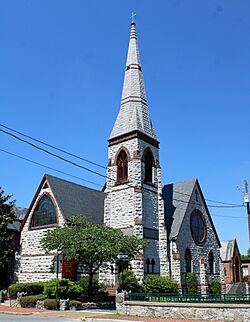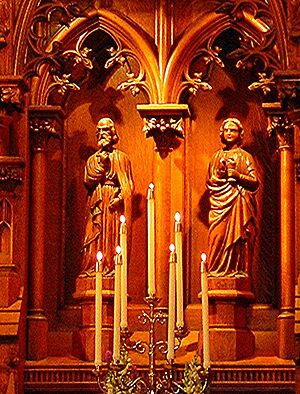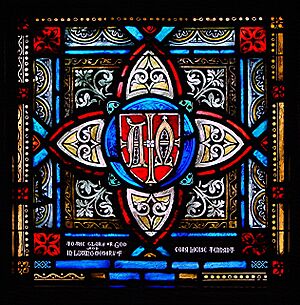Saint John's Church (Hagerstown, Maryland) facts for kids
Quick facts for kids Saint John’s Episcopal ChurchMount Prospect |
|
|---|---|
 |
|
| 39°23′02″N 77°26′01″W / 39.3839°N 77.4335°W | |
| Location | Hagerstown, Maryland, United States |
| Denomination | Episcopal |
| Churchmanship | Broad church |
| History | |
| Status | Parish church |
| Founded | 1786 |
| Founder(s) | Maryland General Assembly |
| Dedication | John the Evangelist |
| Architecture | |
| Functional status | Active |
| Architect(s) | E.T. Littell |
| Architectural type | Church |
| Style | Gothic |
| Groundbreaking | 1871 |
| Completed | 1872 |
| Specifications | |
| Capacity | 300 |
| Administration | |
| Parish | Saint John’s Parish, lower Cumberland valley |
| Diocese | Maryland |
| Province | Third |
St. John's Church, also known as St. John's Episcopal Church, is a very old church located at 101 South Prospect Street in Hagerstown, Maryland. It was founded in 1786. This church is the main church for Saint John's Parish, which is part of the Episcopal Diocese of Maryland. This parish covers most of Washington County, Maryland.
Contents
A Look Back at St. John's History
St. John's Church in Hagerstown has a long and interesting past. It is considered the "mother church" for its area. However, it also came from an older church called Broad Creek Church. The building you see today is actually the fourth church building for this group!
Early Beginnings
The first church building, called the "Chapel in the Woods," was set up in 1747. It was a smaller church connected to All Saints Church in Frederick, Maryland. Church services started there in 1744. About 40 years later, the church members built a brick church on Mulberry Street in Hagerstown. This spot is still used as the church cemetery today.
In 1786, the Maryland government officially separated this church group from All Saints' Frederick. They created a new parish named "Frederick Parish." Later, in 1806, the Episcopal Diocese of Maryland changed the parish's name to honor Saint John the Evangelist.
Important Leaders and Education
One important leader at St. John's was Reverend Thomas P. Irving. He was known for being very smart in Greek and Latin. He taught at schools like New Bern Academy and later the Hagerstown Academy. This focus on learning continued at St. John's Church.
Another rector, Reverend Theodore Benedict Lyman, helped find and buy the land for Saint James School in 1842. This shows how important education was to the church.
St. John's During the Civil War
During the American Civil War (1861-1865), many people who attended St. John's Church supported the Southern states. However, their leader, Reverend Henry Edwards, strongly supported the Union (the Northern states). He even served as a chaplain for the U.S. Hospital in Hagerstown after the battle of Antietam.
It's said that on the Sunday before the Battle of Antietam, Reverend Edwards preached to a church full of Confederate soldiers. Yet, he still prayed for Abraham Lincoln, who was the President of the United States. He did this again on another occasion, even when a large group of Confederate soldiers was present.
The Church Building's Design
The church building you see today was built in 1872. Its design was influenced by a movement called the Oxford Movement. This movement encouraged church designs that looked more like older, medieval churches.
Key Architectural Features
The church is made of rough blue limestone with brownstone details. It has beautiful stained-glass windows in a Gothic style. There's also a tall bell tower with a stone steeple. The two large oak doors are painted red and have fancy bronze designs, similar to those found at Lichfield Cathedral in England.
Inside the tower's entrance, the foyer has an Arts & Crafts style. The ceiling has 60 small six-point stars that are lit from above. The previous church building was destroyed by a fire in 1871, which led to the construction of this new one.
The High Altar and Reredos
In 1899, a former church member named Mollie Magill Rosenberg donated a beautiful Gothic Altar and a Reredos. A reredos is a decorative screen or wall that stands behind the altar in a church. This donation helped change the church's inside look from an older, simpler style to one that looked more like medieval English churches.
The High Altar and Reredos are meant to represent Christ. The Reredos is like a smaller version of a large medieval Rood Screen. A rood screen used to separate the main part of the church from the altar area.
Artistic Details and Meanings
The High Altar has three carvings at its base. The middle carving shows The Last Supper, which is a famous event from the Bible. The carvings on either side show two important stories about Abraham from the Old Testament: Isaac being offered to God and Melchizedek blessing Abraham.
Between these carvings are three figures carved as pillars: Peter, John, and James. These are important figures in the early Christian church. Peter holds keys, John carries the New Testament, and James is shown with a club.
Christ and Saint John are shown three times in the High Altar and Reredos. The design also uses a "three theme" throughout, like the trefoils (three-leaf shapes) that represent the Holy Trinity. The center of the cross design in the Reredos has a bronze carving of the Nativity (Jesus' birth) and the Crucifixion. You can also see the Star of Bethlehem in the center.



